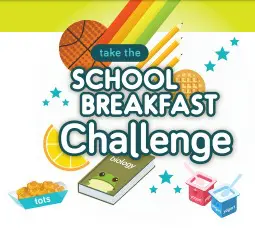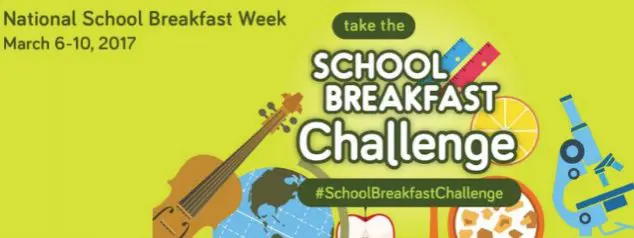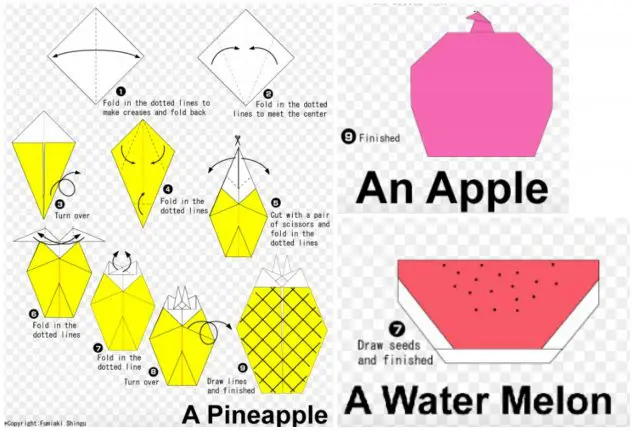March 6-10 is National School Breakfast Week! What is it all about? National School Breakfast Week is about making sure that every kid can and does start their day with a nutritious breakfast. Breakfast is an important meal because kiddos need energy to get them through their morning classes and activities. We all know it is hard to concentrate when you are hungry! Breakfast foods are also an important source of vitamins and minerals our bodies need. It is hard to compensate for missed nutrients later in the day. I have partnered with the national non-profit School Nutrition Association to bring you this post. I truly believe that every child deserves a nutritious breakfast to start the day. Take the School Breakfast Challenge and celebrate with some cute origami fruit kids will love.
Take the School Breakfast Challenge
To celebrate National School Breakfast Week, school cafeterias across the country will encourage students to “Take the School Breakfast Challenge” and kick off their day with a nutritious school breakfast.
It breaks my heart to think it but, the statistics say that one in five children in America live in households without consistent access to adequate food! The School Breakfast Program (SBP) was designed to try to make sure that all kids have access to a well balanced breakfast. Armed with scientific research linking school meals and healthy diets to academic success, school nutrition professionals have worked to expand breakfast programs through innovative delivery methods. Options such as grab-and-go service allow students to quickly pick up their meal from the cafeteria or a hallway kiosk on their way to class. Many schools are even serving breakfast in the classroom so students can enjoy a healthy meal during morning announcements.
Help Celebrate National School Breakfast Week
You can help celebrate National School Breakfast Week by talking to your kids about the importance of a healthy breakfast. Make sure to provide kids with access to breakfast at home or through the School Breakfast Program (a low cost or free program). On the TrayTalk.org blog, you can find out more about daily activities, new healthy menu items and fun breakfast programs being implemented in schools. TalkTray is a great resource for parents and guardians, featuring stories and interviews from school cafeterias and nutrition experts. Also, to get parents in on the fun, the School Nutrition Association will host a National School Breakfast Week giveaway on Facebook.com/TrayTalk
National School Breakfast Week was launched in 1989 to raise awareness of the School Breakfast Program. It exists to help promote the links between eating a nutritious breakfast, academic achievement and healthy lifestyles. The “Take the School Breakfast Challenge” is made possible by the nonprofit School Nutrition Association, Kellogg’s and Potatoes USA. I am thankful that the School Breakfast Program helps put food into hungry children’s bellies!
Easy Origami Fruit Kids Will Love – Make Origami Fruit!
You can also celebrate National School Breakfast Week with a fun some fun, easy origami kids will love. Make some adorable origami fruit with your kids. It is a great time to talk them about how the food we eat helps strengthen our bodies. Kids and adults can participate in this fun activity together.
Origami, the art of paper folding, offers creative opportunities to craft various objects, including fruit shapes. While origami fruits might not be edible, they can be delightful decorations, artistic expressions, or components for themed displays. Here are instructions for making simple origami fruit shapes:
How To Make An Origami Apple:
- Start with a square piece of green or red paper.
- Fold the paper in half diagonally to form a triangle.
- Fold the two bottom corners of the triangle upward to meet at the top point, forming a smaller triangle.
- Fold the two side corners to the center crease, leaving a small gap in the center.
- Flip the paper over and fold the top flap down slightly to create the apple’s stem.
Directions For Origami Watermelon Slice:
- Fold the Watermelon Rind:
- Take the square green paper and fold it in half diagonally to form a triangle.
- Fold the triangle in half again to create a smaller triangle.
- Fold the bottom left and right corners of the triangle upwards, leaving a small gap in the center.
- Unfold the top layer of the flaps slightly to give the rind a jagged appearance, resembling the texture of a watermelon rind.
- Fold the Watermelon Flesh:
- Take the square pink paper and fold it in half diagonally to form a triangle.
- Fold the triangle in half again to create a smaller triangle.
- With the triangle pointing downwards, fold the right and left corners upward, leaving a small gap at the top.
- Unfold the top layer slightly to reveal the red flesh.
- Assembly:
- Place the pink triangle (watermelon flesh) on top of the green triangle (rind), aligning the edges.
- Adjust the positioning so that the red triangle slightly overlaps the green triangle to resemble a watermelon slice.
How To Make An Origami Pineapple:
- Fold the Pineapple Body:
- Take the square yellow paper and fold it in half diagonally to form a triangle.
- Fold the triangle in half again to create a smaller triangle.
- Fold the bottom left and right corners of the triangle upwards, leaving a small gap in the center.
- Unfold the top layer of the flaps slightly to give the pineapple body a textured appearance.
- Create the Pineapple Crown (Optional):
- If you have green paper, cut out small leaf shapes or use a green marker to draw leafy patterns on the top edges of the folded yellow triangle to resemble the pineapple crown.
- Assembly:
- Once the pineapple body and crown (if using green paper) are prepared, place the crown on the top edge of the yellow triangle to complete the pineapple appearance.
These are simplified instructions for basic origami fruit shapes. There are various origami designs available online with varying levels of complexity and realism. Experimenting with different paper sizes, colors, and folding techniques can help create a diverse collection of origami fruits suitable for decoration or artistic purposes.
Conclusion
Pineapples are great for your digestion and a great source of Vitamin C.
Apples are high in B-complex vitamins which are key in maintaining red blood cells and providing us with energy.
Watermelon has some of the highest lycopene levels of any type of fresh produce. Lycopene has been linked with heart health and bone health.
Did you know?
Students who eat school breakfast have been shown to achieve 17.5% higher scores on standardized math tests! That’s not all. They attend 1.5 more days of school per year (No Kid Hungry).
I hope that you Take the School Breakfast Challenge and enjoy the origami fruit craft. All kids should start their day with a healthy breakfast.
Related Posts:
Healthy Eating Choices For Kids
3 Simple Healthy Breakfast Ideas You Will Want To Add to Your Weekly Routine



